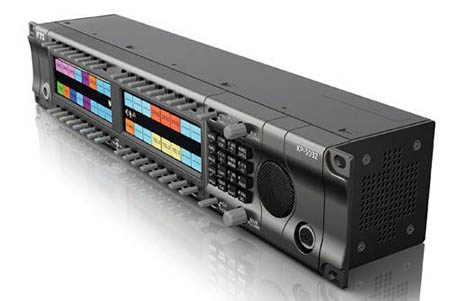Intercoms Becoming More Feature-Rich

Clear-Com’s new Agent-IC is essentially an intercom keypanel for iPads and iPhones.SEATTLE—The earliest intercom systems in broadcast facilities were homebuilt, primarily of telephone components. Now, intercom manufacturers take advantage of digital and networking innovations. And in the case of one new product, reliance on telco technology has come full circle.
“We’ve noticed recently that workflows for people on intercom systems need to be much more mobile,” said Simon Browne, director of product management for Clear-Com in Alameda, Calif. “They’re moving away from their traditional seated positions, and are going outside their trucks or studios, or moving around the live event sites and so forth. And to facilitate that, we recognized that we need to have some sort of mobile client that can still provide intercom functionality back to the intercom matrix.”
AGENT-IC

RTS recently launched the KP Series keypanel for its RTS+ OMNEO product line. The solution Clear-Com has come up with is an app named “Agent-IC,” which are essentially intercom keypanels on iPads and iPhones. At its NAB Show booth in the Central Hall, the company will demonstrate how the app not only handles intercom functionality, but can also make assignments, change sources on IFB, see who’s talking to who, and so forth.
The fact that these i-devices work on 3G or 4G cellular systems as well as over WiFi will give the intercom panels worldwide range, as long as there’s some service connectivity available.
Browne pointed out that there is some latency involved, the worst case being when 3G is the only available cell network service available. “That might prevent it from being used for calling shots or calling IFBs, but it won’t prevent you from listening in to the intercom chatter,” he said. “It won’t prevent you from listening to sound sources.”
To make his case, Browne cited the example of a member of an OB crew who, on an Agent-IC iPhone, could handle maintenance outside the truck, while at the same time be able to monitor the intercom and access the intercom matrix if there’s a problem or need for reconfiguration. “And there’s the fact that you can monitor multiple systems from a centralized site, which is also very helpful,” he said.
The professional video industry's #1 source for news, trends and product and tech information. Sign up below.
FLEXIBLE PLATFORM

Riedel’s new line of “Smartpanels” adds flexibility by separating the hardware from the software. At NAB, Riedel is introducing a new type of device architecture to their intercom system, referred to as the “Flexible Platform.”
“Up until now, you’ve gone out and bought a hardware device, and that’s it,” said Christian Diehl, matrix intercom product manager for the German-based company. “With this new line of Smartpanels, we’ve separated hardware from software, which enables us to do a lot of things that I think will benefit our customers greatly.”
This arrangement provides more flexibility for their customers, according to Diehl. “This way, you buy a piece of hardware—a panel for example—and that comes with different editions of an application,” he said. “The small application doesn’t have much connectivity, just a small number of keys. But you can upgrade the software, and still use the same hardware, and have a much greater variety of functions, more keys, more things that you can do with the same panel.”
This allows the customer to just pay for the functionality that they really need.
Key to the system is that Riedel has designed very powerful hardware that runs under the operating system. Diehl pointed out that separating hardware from software gives Riedel the ability to introduce even more intercom apps. “It will even allow other companies, third parties, to introduce an app for this hardware,” he said. “We’ve made the hardware very powerful, very capable, in terms of user interface, and also in the quality of audio we have in the box.”
The Smartpanels don’t have to be limited to traditional intercom functions since the panels are connected to the network, as are all sorts of devices in a broadcast facility or remote truck. “Say there’s a third party with a video router,” Diehl said. “We could easily do some controlling of that router with our panel.”
THIRD-PARTY CONNECTIONS
Along the same lines of using network technology, two years ago intercom maker RTS introduced the first generation of RTS+ OMNEO products. OMNEO allows the transport and easy control of audio, video and other data over IP networks to provide the highest levels of sound quality along with the lowest levels of latency in a highly reliable and secure setup.
The technology provides options for the interconnection of equipment from different manufacturers, even outside of traditional audio or intercom applications. It is also scalable up to 10,000 nodes and interoperable across multiple IP subnets and long distances.
Just introduced is the first keypanel family with OMNEO IP technology on board, the KP Series. Company executives say the KP sets “a new milestone within the RTS product range, combining HD color displays, improved single key operation and full compatibility with all existing RTS matrices in a modern design.”
The new keypanels feature intuitive operation by ergonomically designed four-way levers providing talk/listen and volume. The KP-Series of panels offer as standard a full range of external connections for GP-I/O and ancillary audio functions, which were previously optional. With a worldwide market in mind, the keypanels can display Latin, Cyrillic, and simplified Chinese characters.
